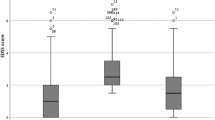Abstract
Seventy-three Dutch and Flemish patients with definite multiple sclerosis (MS) were assessed by means of the Disability and Impact Profile (DIP), which is a 2 × 39 item, self-administered questionnaire with parallel questions aboutdisabilities and their importance for orimpact on the patient, resulting in a profile of weighted scores. It was designed as a tool for clinical assessment of quality of life (QoL) domains in MS patients. Group data showed more than 50% loss on weighted scores for “walk”, “clean home”, “work” and “worry about deterioration”. In individual patients a median of 7 (range 0–23) major disruptions of quality of life (MD-QoL: loss on weighted score more than 50%) was found. Prevalence of MD-QoL in more than 10% of the patients was found for as many as 31 disabilities and > 50% for 3 (“clean home”, “work” and “worry about deterioration”). Results in the MS group were compared with available data from 25 patients with rheumatoid arthritis (RA) and 25 patients with a spinal cord lesion (SCI). Weighted scores of “read”, “memory” and “concentration” were significantly lower in the MS group than in the RA and SCI groups. Significantly lower weighted scores in both the MS and RA groups compared with the SCI group were found for “worry about deterioration”, “physical endurance”, “clean home”, “work”, “see” and “write”. In conclusion, major disruptions in many domains of QoL were found in MS patients. Weighted score profiles for MS were in accordance with clinical manifestations. Unlike Kurtzke's Extended Disability Status Scale, DIP assesses a wide range of potentially MS-affected human activities, and also takes into account the subjective perception of disabilities.
Similar content being viewed by others
References
Anonymous (1991) Recognising disability. Lancet 338:154–155
Bennekom CAM van, Jelles F, Lankhorst GJ (1995) Rehabilitation Activities Profile: the ICIDH as a framework for a problem-oriented assessment method in rehabilitation medicine. Disabil Rehabil 17: 169–175
Guyatt GH, Eagle DJ, Sackett B, Willan A, Griffith L, McIlroy W, Patterson CJ, Turpie I (1993) Measuring quality of life in the frail elderly. J Clin Epidemiol 46: 1433–1444
Haan R de, Aaronson N, Limburg M, Langton Hewer R, Crevel H van (1993) Measuring quality of life in stroke. Stroke 24: 320–327
Jiwa-Boerrigter H, Engelen HGM van, Lankhorst GJ (1990) Application of the ICIDH in rehabilitation medicine. Int Disabil Stud 12: 17–19
Kurtzke J (1981) A proposal for a uniform minimal record of disability in multiple sclerosis. Acta Neurol Scand 64 [Suppl 87]: 110–129
Kurtzke J (1983) Rating neurological impairment in multiple sclerosis: an Expanded Disability Status Scale (EDSS). Neurology 33: 1444–1452
Laman H, Lankhorst GJ (1994) Subjective weighting of disability: an approach to quality of life assessment in rehabilitation. Disabil Rehabil 16: 198–204
Lankhorst GJ (1989) Quality of life: an exploratory study. Int J Rehab Res 12: 201–203
Mellerup E, Fog T, Raun N, Colville P, Rham B de, Hannah B, Kurtzke J (1981) The socio-economic scale. Acta Neurol Scand 64 [Suppl 87]: 130–138
Polman CH, Lankhorst GJ (1993) Assessment of quality of life in multiple sclerosis. In: Ketelaer P, Battaglia MA (eds) Rehabilitation in multiple sclerosis. Proceedings of the 2nd European workshop, May 29–30 1992, Brussels (Belgium). A.I.S.M., Genova, pp 64–69
Poser CM, Paty DW, Scheinberg L, McDonald WI, Davis FA, Ebers GC, Johnson KP, Sibley WA, Silberberg DH, Tourtellotte WW (1983) New diagnostic criteria for multiple sclerosis: guidelines for research protocols. Ann Neurol 13: 227–231
Rudick RA, Miller D, Clough JD, Gragg LA, Farmer RG (1992) Quality of life in multiple sclerosis. Arch Neurol 49:1237–1242
Steinbrocker O, Traeger CH, Batterman RC (1949) Therapeutic criteria in rheumatoid arthritis. JAMA 140: 659–662
Stensman R (1985) Severely mobilitydisabled people assess the quality of their lives. Scand J Rehab Med 17: 87–99
Tugwell P, Bombardier C (1982) A methodologic framework for developing and selecting endpoints in clinical trials. J Rheumatol 9: 758–762
World Health Organization (1980) International classification of impairments, disabilities and handicaps. WHO, Geneva
Author information
Authors and Affiliations
Rights and permissions
About this article
Cite this article
Lankhorst, G.J., Jelles, F., Smits, R.C.F. et al. Quality of life in multiple sclerosis: The disability and impact profile (DIP). J Neurol 243, 469–474 (1996). https://doi.org/10.1007/BF00900502
Received:
Revised:
Accepted:
Issue Date:
DOI: https://doi.org/10.1007/BF00900502




